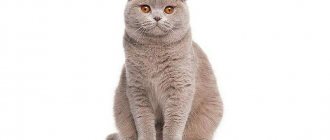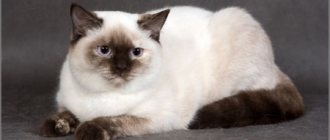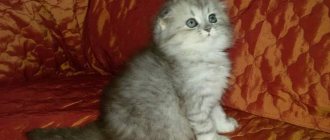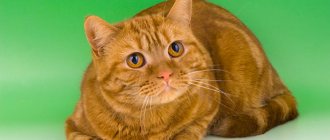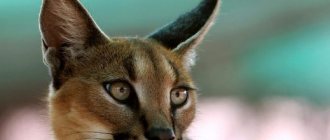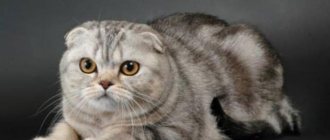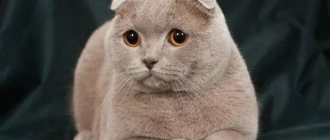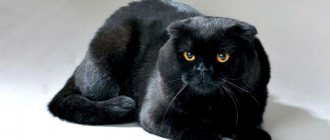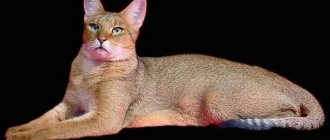At the beginning of the last century, England was the felinological center of Europe. Breed standards were drawn up here for the first time, the first cat show in world history was held, and 3/4 of the 170 animals announced for participation in it consisted of British shorthair cats. Among them they found a kitten with curled ears, which became the first representative of the new breed.
British Fold cats quickly gained popularity and took pride of place in the breed hierarchy. Subsequently, a standard was drawn up for them and their character, habits and health characteristics were studied in detail.
Brief history of the breed
Experts disagree on exactly when the British Fold appeared.
- The first version dates back to the time when the ancient Romans conquered Britain (around 43). Egyptian cats also came along with the invaders, who later adapted to the new climatic conditions.
- Another hypothesis mentions the Crusades - the warriors appreciated the useful abilities of the eastern rat catchers and brought them home.
- Cats infiltrated merchant ships that sailed between the Old Continent and Africa. There were always a lot of mice on ships, and the crew favored small animals that helped get rid of rodents.
What is known for certain is that the first British cats came to the European mainland from North Africa and the Middle East. Further formation of the breed took place under the influence of local conditions: the animals developed thicker hair and developed immunity against diseases common in the area.
What is the difference between a British Fold and a Scottish Fold cat? Special ears
When kittens are born as a result of mating between straight-eared British and fold-eared Scots, it is not yet possible to determine what kind of ears they will have. The time from birth to four weeks is the longest for a breeder. During this period, the ears are formed, and it will soon become clear which kittens are produced: Scottish Folds or Scottish Straights. This is how the Scottish cat differs from the British cat. Scottish Folds do not immediately acquire their special ears. At the same time, the British can only be straightforward.
Up to six weeks, kittens' ears are considered fully formed. But their bend in Scottish folds also varies. If it is simple, then the tips of the ears are only slightly tilted forward. When double and triple folded, they fit tightly to the head, like a cap. This option is the most desirable for the breeder. It is these kittens that often become winners of various cat shows.
Interesting facts about the British cat breed
Descriptions in ancient books and images in paintings indicate that the first British cats were not fold-eared:
- The Gospel from Lindisfarne (7th century) contains an image of a cat that is very similar to the modern Briton.
- The Book of Columba, a recognized handwritten masterpiece of the Irish monks, also contains illustrations of straight-eared cats.
You can read more about straight-eared Britons in this article.
Artists and sculptors depicted them to pay tribute to the beauty and grace of these animals. The monks wrote in poems that the life of hermits becomes more interesting and fun if a cat lives nearby. She was the only pet allowed to live on the grounds of nunneries.
This is interesting! England became the first country to pass a cat protection law. In 936, the English prince Howell Dda issued a decree prohibiting any violence against these animals.
Features of breeding fold cats
If you want to try your hand at breeding purebred cats, then it’s better to start by studying in felinological courses, which teach the basics of genetics, veterinary medicine, and tell you about the rules for holding exhibitions and about international felinological organizations. Before organizing the mating of your pet, it is necessary that he take part in the exhibition. Even if the cat did not take a prize, it received a rating for its class, this could be:
- Pet class is an animal with a slight defect that cannot be used in breeding work.
- Breed class - full compliance with the breed standard and in good health for procreation.
- Show-class - not only compliance with the standard, but also a bright appearance, which allows you to receive prizes at exhibitions.
Only after receiving the class can your pet officially take part in the breeding work of the felinological club.
The difficulty in breeding fold cats lies in the correct selection of partners. Under no circumstances should fold-eared cats be mated with fold-eared cats. In such a mating, all offspring will have genetic diseases. In addition, the color of the animals is taken into account to obtain the best result.
It is advisable to breed young animals with more experienced partners at the age of about one and a half years (a cat during the third heat). To find a suitable partner, a felinological club is used and the act of mating is documented so that the kittens born have a correctly issued passport.
Description of the British Fold breed: standards, appearance and character of the cat
The breed standard details the characteristics required for the breeding of the British Fold cat.
Dimensions and weight
A strong, medium-sized cat with a dense build. Newborn British Fold kittens weigh from 70 to 130 g. In the first week, body weight increases 1.5 times. Further indicators will depend on the gender of the pet - boys gain weight faster, and girls are traditionally more petite and graceful.
The average weight of an adult British cat is 8 kg, and female cats are usually 2-2.5 kg less. The average height of an animal is 28-35 cm, with cats being approximately 5 cm taller than female cats.
Important! One of the peculiarities of the breed is that the British reach puberty at 2 years of age, but they gain weight before the age of 5.
Anatomical characteristics of the British Fold - what a cat of this breed looks like
British fold cats can be divided into three groups:
- Traditional British Shorthair. The auricles are small, with a slight rounding at the apex. The coat is thick and shiny. Powerful and flexible tail of medium length.
- Long-haired cat. Breeders crossed the British with other breeds (Persians or representatives of the Somali branch) in order to obtain new colors. But in addition to color, the animals inherited long hair from their parents. Such kittens were first culled, and later interbreeding was prohibited. But the population of mestizos increased and was subsequently officially recognized by felinologists as the British longhair cat.
- Fold-eared Briton. A cat with short, thick hair and ears that curve forward. The body is wide, the paws are low. Some international felinological organizations do not officially recognize the breed because they consider lop ears to be a defect that was caused by a gene mutation.
This is interesting! All newborn kittens of this breed have straight ears, so it is impossible to immediately determine whether the pet will have fold ears.
British coat color and type
The Scottish (or British Fold) breed took from its parent branch a short, thick coat with a dense, elastic texture and a warm undercoat.
Traditional colors include:
- blue lop-eared British;
- gray fold cats;
- tabby tabby cats.
There are about 200 combinations of different colors in the colors of the British Fold cat breed, including the exotic acromelanic color point.
Possible breed defects
An uncontrolled mutation negatively affects the condition of skeletal bones, joints and spine in (Scottish) British fold cats. To counter the deterioration of the genotype, felinologists and breeders had to develop some rules that prevent the development of irreversible defects.
- When crossing, the union of two fold-eared parents is avoided. In a cat “marriage,” a British Fold is matched with a cat from a different breed—an American Shorthair or an exotic.
- Even as a result of mating with representatives of other breeds, offspring may be born that are predisposed to loss of tail flexibility due to fused vertebrae. For this reason, felinologists cull short-tailed British cats, which are more prone to developing this disease than others.
Geneticists were able to find out how this mutation affects the health of the British Fold cat. It turns out that negative consequences occur only in the presence of a homozygous form, when both acquired genes are present in the same paired state.
Alleles that scientists have already studied are responsible for lop ears. In the FdFd variant, they lead to irreversible consequences, and the Fdfd combination is completely safe for the health of the British Fold cat.
Important! If the cat has signs of lameness, and small kittens avoid active movements such as running and jumping, this is a signal of the presence of a congenital disease.
Colors
The coat of a British cat can be either monochromatic or multi-colored, including 2 or 3 colors.
Plain “British” ones are:
- blue (classic version);
- silver-gray;
- white;
- black;
- brown;
- red;
- peach.
Multi-colored cats are:
- tabby (striped color);
- bicolor (a combination of dark and light colors);
- smoky (each hair is transversely divided into two shades);
- "Siamese";
- "tortoiseshells".
The character and temperament of the British (how they treat children, do they get along with other animals)
The habits of the British Fold cat and its character do not at all correspond to the parent breed:
- The behavior of the British cat is balanced; it does not show aggression towards others.
- A distinctive character trait of the British Fold is devotion to the owner and other family members.
- Despite their sociability, representatives of this breed can easily tolerate loneliness.
- British cats get along well with children and enjoy taking part in general games, but do not like to be treated roughly.
Price
There are many nurseries selling British fold kittens in Russia; finding a pet is not a problem. The breeder must provide the buyer with a veterinary passport and information about the kitten’s parents.
If prices for a purebred “Scottish” cat reach 50 thousand rubles, then a British kitten is much cheaper, because this fold-eared cat is an unrecognized breed. For a British fold kitten they ask from 1000 to 5000 rubles.
The lop-eared “British” is loyal, affectionate, playful, and behaves with dignity. Although he cannot participate in exhibitions and competitions, since his breed does not officially exist, he will become a wonderful companion for a lonely elderly person and a friend for a large family.
Did you like the article?
Leave the content of the British
British cats are short-haired, so they are brushed at least once a week, and every other day during heavy shedding. To care for the fur, use standard “cat” combs or special gloves, which can be purchased at a pet store.
The presence of slight discharge from the eyes and nose is normal for the British Fold cat. The owner needs to regularly carry out hygiene procedures - clean the nose and eye area from dirt.
Particular attention should be paid to cleaning the ears of a British Fold cat. The unusual structure of the shell complicates the procedure, so you need to act very carefully so as not to harm your pet.
- First, the bent tip of the ear is bent and access to the inside is freed.
- Using a cotton swab, carefully clean the areas that are in your field of vision.
- For deeper cleaning, use special ear drops or other preventive liquid preparations that can be injected into the ear canal.
Unusual cat behavior is a cause for concern. If your pet shakes its head or there is an unpleasant odor coming from the ear, you should immediately seek help from a veterinarian.
Feeding a British Fold cat
The diet depends on the individual characteristics of the cat. The pet owner must choose one of three options:
- natural food;
- industrial feed;
- mixed feeding.
Practice shows that in real life all three points are used. During childhood, owners and breeders most often feed British Folds with homemade food and independently calculate the portion and calorie content.
Adult cats switch to dry kibble without any problems. And in old age, the animal happily eats both the first and the second.
Important! Representatives of this breed are prone to overeating and gaining excess weight. This is dangerous for the cat's health, since it has a genetic predisposition to diseases of the bones and joints.
Description of character
Despite the differences between the British Fold and his ancestors from essentially different breeds, he took the best - incredible friendliness and affection for his owners, balanced disposition and calmness. He loves games, but he never imposes himself, and is also easy to basic training.
To get an obedient pet with a gentle disposition, the owner is required to give up unreasonable aggression and rudeness towards him.
"Lop-eared" becomes attached to the owner
This cat loves to eat, which may be why she quickly becomes attached to the person who feeds her. Therefore, it is advisable that the owner himself does this if he wants to receive devotion and obedience in response to care and affection.
Such a pet is independent and self-sufficient, and is considered an ideal option for a person who is busy at work for a long time.
So, he can remain alone for a long time, but he will always happily meet the person to whom he is attached.
In addition, the cat loves to just sit next to the owner or work with a claw sharpener, and if necessary, he will easily support the game he has started. But at the same time he never sits in his arms and does not tolerate hugs.
Temperament
Like the Scottish Fold, the British Fold is very inquisitive and gentle. Therefore, the maximum that you can get from him in case of dissatisfaction is a loud cry and a dissatisfied look.
It is also worth remembering that a long flexible tail is a pet’s special pride, and, in his opinion, always requires careful handling.
The British is clean and always looks respectable, which should also be remembered. That is, you need to be prepared for the fact that it will require constant attention from a person.
He is very independent and independent, requires personal space and respect from people. Without receiving anything, he will begin to show his dissatisfaction, which will lead to problems in mutual understanding.
In general, a cat can be either calm and balanced, or active and restless, which manifests itself in each individual case in its own way.
Pride in such a representative of the family can be combined with playfulness, and gentleness of character with an interest in hunting and tracking down the intended prey.
Relationships with other household members (children and dogs)
The behavior of the Fold remains friendly to everyone; he does not perceive aggression from the outside and does not show it himself. He gets along well with dogs and other pets. He dotes on children, playing with babies and cuddling with them for hours or falling asleep next to the child. Also read the article about the best cat breeds for children.
The main rule here is not to touch the tail and not to offend it in general, otherwise the cat will simply run away, maybe even leave the house.
In some cases, teeth and claws can be used against adults, but such a negative attitude will manifest itself immediately, because they do not know how to harbor a grudge. We recommend reading the article about breeds prone to aggression.
Education and physical activity
Despite their sociability, the British are independent and willful. Therefore, when training and raising a pet, certain rules should be followed:
- You need to show your cat your dissatisfaction immediately after committing an offense.
- It is important to maintain consistency in the training process - for example, you should not allow your pet to sharpen its claws on the back of a chair today, and scold your pet for it tomorrow.
- Praise is very important for the British Fold - do not forget to reward the cat for positive actions.
Physical activity is one of the main indicators of an animal’s quality of life. It is necessary to provide the animal with sufficient space for play, prepare toys and be sure to engage with it.
How the British became related to the Scots
After fold-eared cats were banned in Europe, work with them continued in the USA. Due to the high mortality rate of kittens, Scottish Fold + Scottish Fold matings were also banned in America. Folds began to be crossed with the British Shorthair, Persian, and American Shorthair. The British and Scots were especially active in connecting with each other. They wanted to add new colors to the British, and to make the Scots with thicker fur and massive bones. From such matings, both fold-eared kittens and babies with normal ears were born, who were called straight. Animals with different hair lengths also appeared - Highland Fold (long-haired fold), Highland Straight (long-haired straight-eared). There are 4 varieties of Scottish cats.
Vaccinations and antiparasitic treatments
A standard scheme for the prevention of internal and external parasites (endo- and ectoparasites) is applied to British cats.
Before a kitten goes to a new owner, the nursery must carry out deworming and flea treatment. In the future, preventive measures are carried out according to the following scheme:
For lop-eared Brits who don't go outside:
- Treatment against external parasites using drops or in combination with a special collar – once a month.
- Antihelminthic procedures are carried out once every 6 months, in the first week after treatment against ectoparasites.
Cats that go outside are dewormed and treated for external parasites 2 times more often.
Important! You can become infected with worms and fleas even in an apartment - the larvae are brought into the room with shoes or clothes.
Own territory
British Folds can be called lovers of personal space. Yes, they need privacy, to be with themselves. Unlike other cats, this breed cannot be scared away by rustling bags; they are quite brave. Such attempts to scare away will, at most, result in a surprised face.
Once again, it is worth noting that pets get along well with other animals and are not jealous.
If they tell you that an animal chooses its owner, you can smile - this is not about the British. Pets tend to look at what is happening from above; they can climb to a height and watch what is happening like an emperor.
Sterilization and castration
In order not to deteriorate the breed, experts recommend spaying/castrating cats with minor or critical defects. Not everyone knows that sterilization and castration of animals are two different procedures, and cats are also castrated.
- Sterilization does not involve the removal of organs, but only limits their reproductive functions. It is considered more gentle and humane towards animals. However, after sterilization, the behavior of cats does not change. They still have a natural desire to mate, but are physically unable to produce offspring.
- Castration is carried out on both male and female cats. As a result of surgery, the testes (for males) and ovaries (for females) are removed. The production of sex hormones stops, reproductive function is absent.
Hidden dangers of surgical procedures exist, but such operations are always planned and have already become familiar to veterinarians.
Consequences of mating a Briton and a Fold
As a result of crossing, both the British and Scottish cats were losers:
- The British began to have an elongated body, a smaller muzzle, and lost the beauty of their coat. Such mating gave the British absolutely nothing.
- The Scots “earned” problems with the skeletal system. After all, the powerful bones acquired from the British did not combine well with the gene for lop ears. The ears were also damaged. The British-Scottish descendants did not have perfectly formed, small ears. When mated to Britons who do not have the lop ear gene, the kittens' ears are often loose and have a wider base. And over time, such ears can stand up.
- Straight cats turned out to be completely different in type. Some were massive, squat, almost matching the British standard. The second ones are elongated, with long legs and a tail.
Pros and cons of the British cat breed
| Positive traits | Negative qualities |
| Unusual appearance | Tendency to genetic diseases |
| Sociability and loyalty to all family members | Ears require special care |
| Good learning ability | |
| Resistance to common diseases |
Experts believe that it is already possible to detect the presence of genetic diseases in a British Fold cat at the age of 3-5 months. In addition, conscientious breeders adhere to recommendations regarding mating in order to improve and strengthen the breed.
In such conditions, the risk of developing pathologies is reduced to a minimum, which means that the risk of acquiring a sick animal is significantly reduced. A healthy and cheerful fold-eared cat is always joy and good mood for its owner.
Health, reproduction, kittens
British Folds were created through crossbreeding, so they can be quite sickly.
In particular, they have a high risk of developing the following pathologies:
- Deformation of cartilage in some individuals affects not only the shape of the ears, but also the entire spine. Therefore, they may experience fusion of the vertebrae, shortening of bones and thickening of joints, and the appearance of bone growths, which can only be corrected surgically.
- Hypertrophic cardiomyopathy (HCM) is a genetically determined uneven thickening of the interventricular septum and ventricular walls. Progresses to heart failure with chest pain. The disease makes itself felt in individuals after a year and is detected by ultrasound.
- Obesity. Due to a good appetite, if you do not monitor your pet’s nutrition and activity, it can gain excess weight quite quickly. This in turn will lead to many health problems. A proper diet, outdoor games and plenty of space in the house or yard increases his activity and reduces the risk of illness.
- Worms, fleas and other parasites come from the outside, are absorbed with food or hairballs when licking, especially if the cat is in contact with other animals. Now there are many means to get rid of them, which are best used as prescribed by a veterinarian.
- Infectious diseases. These are immunodeficiency, aspergillosis with chronic runny nose, calcivirosis and rhinotracheitis. And especially life-threatening peritonitis, panleukopenia, leukemia, rabies, tuberculosis. To prevent them, vaccinations are necessary: annual against rabies starting from the age of 8 months, and others no later than the three-year period when maternal immunity is still in effect.
On average, adults live from 14 to 20 years if you monitor their condition.
For example, periodically lifting an animal by its front legs reduces the likelihood of developing spinal pathologies. Timely and proper care will avoid many other problems.
Particular attention should be paid to the issue of breeding pets. If owners want to get healthy offspring, under no circumstances should individuals with the same gene be crossed when both of them have drooping ears.
It is worth taking individuals with straight and curved ears, it is better if both of them belong to the British breed. And after 9 weeks it will be possible to get a mixed litter, but the likelihood of their mutation is significantly reduced.
The peculiarity of lop-eared cats is that they are all born with erect ears. They acquire their shape only on the 21st day, then it will be clear which of the babies will be straight-eared and which will be a typical representative of the British breed.
The owners will only have to choose suitable nicknames, remembering that the British are proud and independent animals, and they will serve their family faithfully.
Care
Newly-made owners of British Fold cats often wonder how to care for their charges. It's actually very simple. Representatives of this breed do not require particularly complex grooming.
If we talk about combing the coat, then you should start from the type of coat the British Fold has. If the pet has long hair, then it needs to be brushed 3 times a week; If you have short hair, then once a week will be enough. This action should not be forgotten, since it is necessary to ensure that the cat’s stomach does not become clogged with hairballs from licking. By the way, fold-eared cats are one of the few who like brushing against the grain. This is a great massage! The British ears require special attention. The unusual structure of the auricle leads to the accumulation of dust, dirt, and wax in it. Every 2 weeks you need to check your pet's ears. They should not have an unpleasant odor, dirt or rash. If the sulfur is dark in color, has an odor, or has a rash, you should contact your veterinarian as these may be symptoms of an illness in your cat. To clean, you will need a cotton swab dipped in a special liquid for cat ear hygiene. The eyes of British Fold cats do not require special care. In the morning, the owner should check for dark plaque in the corners of the eyes - it must be carefully removed with a napkin soaked in boiled water. The presence of purulent discharge indicates that you urgently need to consult a specialist. British breed cats need to have their claws trimmed once every three weeks. To do this, it is better to use special tools that can be bought at a pet store - a nail clipper and a scratching post. Do not use regular scissors as they may cause damage to tissue and nerve endings. It is enough to trim the claws by two millimeters. Before trimming a claw, you need to hold it up to the light. This will make it clear where the blood vessel is located so as not to touch it. Water procedures are very rare. A British Fold cat should be washed once every 6 months. Of course, you will have to resort to washing if the Briton gets very dirty
When fleas appear, it is important to regularly perform water treatments. The water temperature should be no higher than 40 degrees
When bathing, you must use special hygiene products for cats. After water procedures, you should protect your pet from drafts. A cat's fear of bathing is a myth. They are not afraid of water, but of immersion in it, they are afraid of drowning, so they should be taught to take a bath from the first months. The animal will get used to bathing after just a few procedures.
Nutrition
Another important question that worries future owners is what to feed their British cat. British cats, like other cats, can be fed both natural products and dry food. It must be taken into account that these pets need a balanced diet, rich in substances and microelements necessary for the body.
- If a cat eats dry food, then you should not additionally feed it with other foods. Ready-made food, as a rule, already meets all the characteristics: it is balanced and contains useful microelements.
- If the owner prefers natural products, then he needs to create a diet. The basis is lean meat. When fresh, it can be beef tenderloin; when cooked, it can be fish and poultry meat, separated from the bones and skin. The British also love boiled eggs.
- Fold-eared cats can be given cottage cheese and kefir. Fatty dairy products, such as cream or sour cream, can be included in the diet no more than once every 2 weeks. Frequent consumption of high-fat foods causes liver disease.
- Vegetables for British Folds can be fed with cabbage, cucumbers, carrots and zucchini.
- The British diet should include cereals such as oats, millet and rice. They are prepared in meat broth or milk. You can add pieces of meat to the porridge.
- The pet should be fed 2-3 times a day. Food should be in small portions. The cat must have fresh drinking water and it must be changed regularly.
The British Fold cat is the kindest animal that you can’t help but love. She is not picky or aggressive, easy to care for and feed, gets along well with people and animals... Isn’t this the ideal cat?
Acquisition
Before you decide to buy British cats with curled ears, you should evaluate your capabilities, both financially and in terms of caring for your pet. Yes, the price of one kitten of this breed may vary. This depends on many factors:
- Purebred.
- Color.
- Age.
- Availability of vaccinations.
It is clear that blue cats will cost significantly more. When purchasing, you don’t have to worry about the young age of your pet. Especially for toilet training.
Rules
When serving, pay attention to the temperature of the food. It should be within 27-28 degrees. Don't pour too much. Be sure to have clean drinking water in the bowl. Replace every day. Animal fur also requires proper care , otherwise you will have to collect it throughout the apartment. Combing should occur at least 3 times a week. If your pet has short hair, once will be enough. Washing should be done once every six months. Before swimming, make sure that the collected water does not exceed 40 degrees. After washing, wrap it in a towel, hiding it from drafts.
© shutterstock
Just like a child, a cat needs to take care of its ears. When swimming, be careful not to let water get in there. In addition, clean your ears. To do this, you will need a cotton swab previously soaked in hydrogen peroxide.
The story of human friendship with felines
Even in ancient times, representatives of the cat family attracted people not only with their appearance, but also with their unusual behavior. Having earned a positive attitude from people, cats became objects of worship; in some countries they were considered sacred animals, and a person could even be executed for intentionally or unintentionally causing bodily harm to them.
Despite the fact that cats belonged to the category of predators, they were nevertheless calmly allowed into the house, even if there was a small child there. Very smart and friendly, but at the same time quite independent and independent animals have securely taken their place in the human heart and many centuries ago laid the foundation for many years of friendship and trust.
How to educate correctly?
If you have purchased a kitten that is already litter box and scratching post trained, you are very lucky. The baby will not be a mess: the walls, furniture and curtains will remain in perfect order.
You will have to raise a kitten that does not know the rules of good manners yourself from “young claws”:
- introduce the kitten to the house and its inhabitants;
- show him his toilet and sleeping place;
- bring it to the scratching post, which is best purchased in advance, or immediately after the kitten arrives at your house.
If you don’t want your baby to climb onto your bed or table, eat your favorite flowers on the window, or go to the toilet where it’s not supposed to, you should scold the kitten if you catch him in the act.
Punishing an animal after you have discovered the “result” of its activity is absolutely useless.
The cat will not understand why he received a slap in the face.
You should not raise your hand to an animal. This method is completely ineffective with British cats.
It is much better to say the word “impossible” in a stern and confident voice and scold the kitten with the words: “bad”, “disobedient”, “unscrupulous”.
Based on the intonation, the cat will quickly understand that it has done something wrong and will try not to repeat the mistake. Innate intelligence will not allow the child to play dirty tricks if he realizes that he has made a mistake.
To cope successfully with the tasks of education, you need to eliminate “places of temptation” for the animal:
- rearrange the furniture so that the kitten cannot reach the walls and tear the wallpaper;
- block the approaches to the curtains on which he wants to ride;
- place the scratching post in the animal’s field of vision and move it there when it sharpens its claws on the furniture;
- spray with a special spray the places where the kitten did his “business” by mistake;
- smear the tips of the leaves with mustard so that the animal no longer eats the plant;
- praise your pet for good behavior, treat him with a treat immediately and in the same place to consolidate success.
It must be remembered that:
- the British are afraid of noise, so you can’t shout at them;
- hitting a cat means losing its trust and love forever;
- any ban – once and for all; the system “today you can, but tomorrow you can’t” is unacceptable;
- do not allow your loved ones to allow your cat to do what you prohibit;
- like a small child, a kitten also needs to be given time;
- The cat will grow up kind and obedient if you are patient and attentive to it.
